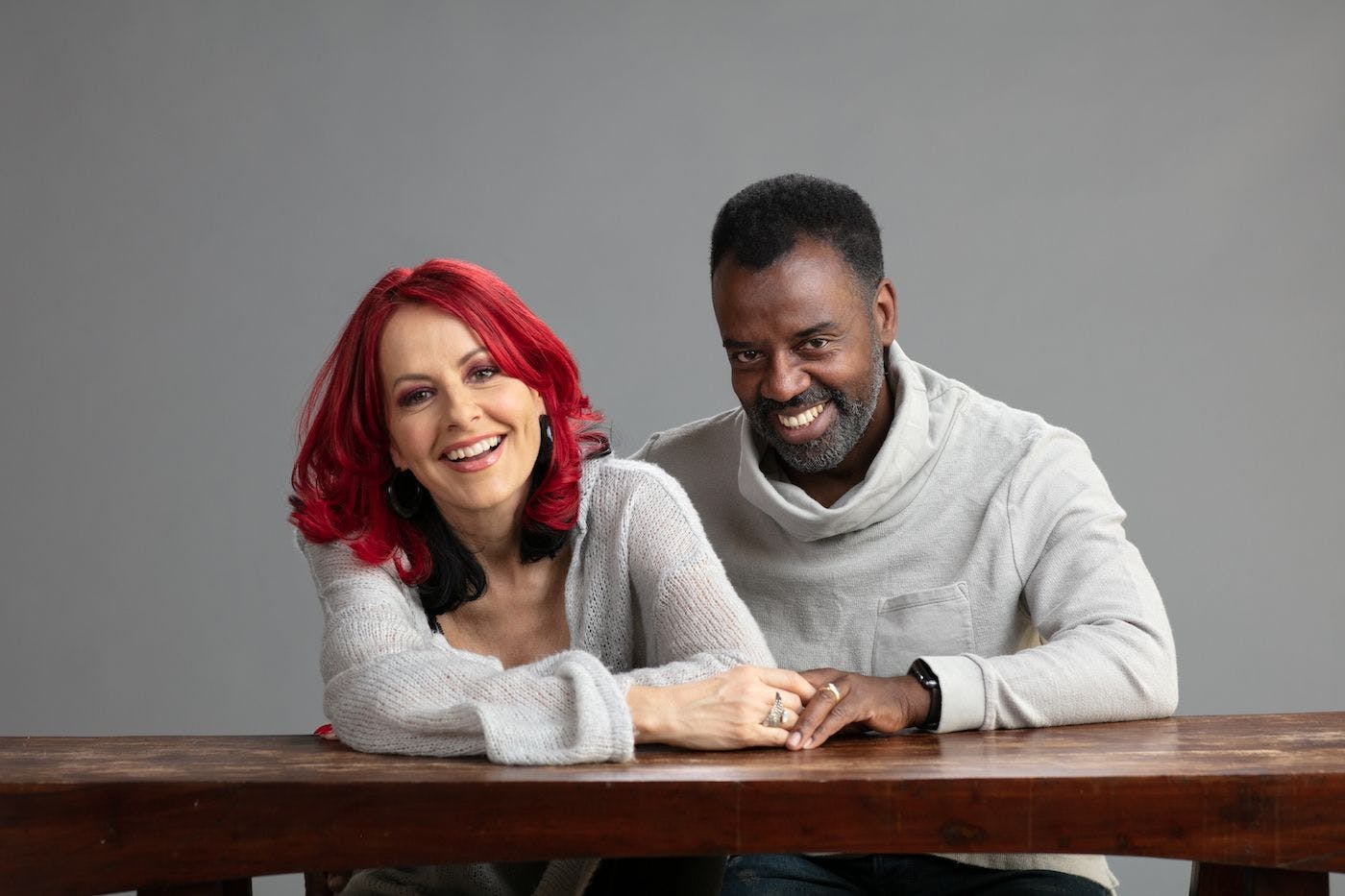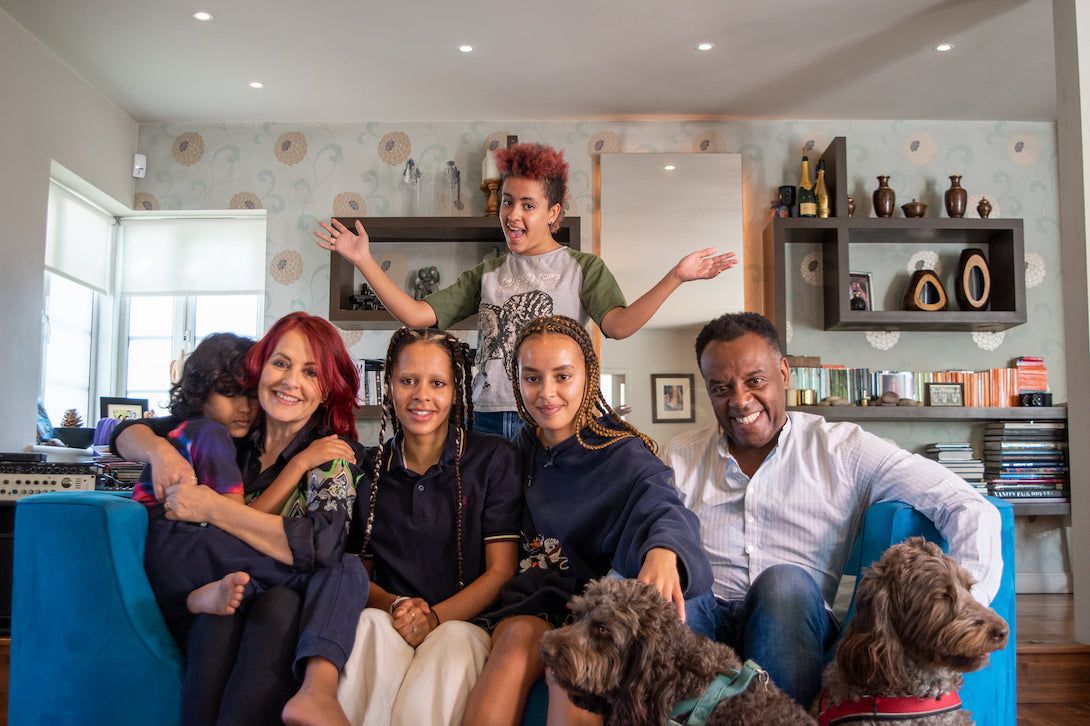
As the world gradually opens its eyes to understanding neurodiversity, as well as the spectrum of gender, parenting expert Carrie Grant reveals to interviewer Gemma Calvert eight compelling and valuable lessons she’s derived from raising her four children in the modern age
Sharing four children with her fellow vocal coach husband, David, parenting expert Carrie Grant knows all too well the parental pressures and complexities of nurturing children in today’s world. Referencing her own experiences of raising Olive (28), a non-binary actor, Tylan (21), who is trans masculine and plays Brooke in Hollyoaks, and Arlo (17) who is currently male-identifying, with all three on the autism spectrum, alongside adopted son Nathan (13) who is traumatised, Carrie shares the eight most significant lessons she has learning from navigating parenthood in a gender fluid and neurodivergent age.
1. Listen. Always.
When a child tells us a worry, our response often starts with a reassuring ‘don’t worry’, that simply invalidates their overwhelming feelings of anxiety. In short, we’ve not heard them.
For so long I ignored what my kids were trying to tell me by talking over them and attempting to problem-solve. When they were getting bullied at school, they’d say, “I’ve got no friends,” so I’d say “You’re lovely, of course you have friends, because you’re such a sweet child.”
About 10 years ago I started doing trauma therapy, and learned about the communication model where you repeat back to your child what they have said word for word, which gives them time to slow things down, and shape what they really feel.
2. Remember your worth
When we hold support meetings for parents with neurodiverse and transgender children, the 50 parents are there because they’re seeking help, and trying to make sense of what’s going on, which makes them great parents. Buying books to learn how to be better also makes you a great parent. We’ve got to change attitudes of blame and shame, and what is normal or successful in parenting.
If your child goes to school, but only gets their hair brushed once they get home, they still learn, have friends, and social engagement. So many things are not deal-breakers. Others who don’t face your challenges may judge the quality of your parenting by your child’s unkempt hair, but they have no idea of the mountain you’ve had to climb just to get them into school.
3. Learn not to push
When Tylan was 14, feeling very depressed and self-harming, I couldn’t solve their problems, because you can’t stop someone being depressed, so I decided to knock on their bedroom door, go in and sit on the end of the bed, and say, “I’m just going to sit here with you for a minute.” They then counted for 60 seconds and said, “You can leave now.” The next day, I went back in and sat for another 60 seconds. Over a week, I increased each visit to three minutes, and after two weeks, Tylan said, “I’m so so sad” and began to really share. Rather than jumping in with a solution, I said, “I know you’re sad. I can’t change that, but I can sit with you in it. I love you and I’m here.” Now Tylan will say, “Mum, can you come and sit on my bed?”
In trauma therapy, I learned about nonviolent resistance where you don’t shout, or get annoyed when your child is melting down. You just stay calm, and gently resist without doing anything. In that instance, I wasn’t asking Ty to try to be happy. I just shared their space, and eventually things began to shift. They started to open up.
4. Really explore those feelings
The world has a very loud voice at the moment, particularly because of social media, which can shut down our own perception of how we’re truly feeling.
When Nathan was about four, a trauma therapist said, “The next time he’s crying or shouting, ask him where in his body the anger is coming from.” When I tried it, Nathan pointed to his tummy, so I said, “I can see that. Can I put my hand on your tummy? Let’s just think about that because that anger doesn’t need to be there.”
Locating that anger – or any emotion – to a place and acknowledging that it’s there won’t remove the trauma, but it will help alleviate confusion and, in turn, help calm the child.

5. De-escalate, then strike while the iron’s cold.
When your child is having a meltdown, it’s tempting to say, “You need to stop screaming right now” and justify why. A child cannot learn anything while they are emotionally dysregulated, because all their systems have gone into fight or flight. In that moment, do what is necessary to help them calm down as quickly as possible – moving away if necessary – and avoid shouting back at them.
Later, when the child is calm, talk about what happened. Nine times out of 10, my children will say, “I’m really sorry I shouted,” and my response will be “I hear you, I understand, and you’re always forgiven, but what might you do in the future?”
Making the child confront their behaviour without shame, by neither being passive nor aggressive, by equipping them with language that will help them in the real world when someone or something triggers them, that’s empowering.
6. Google is free.
When your kids hit their teens, they may identify with a gender that’s different to the one they were assigned at birth, and they shouldn’t be responsible for educating you. Answering questions can be irritating for a youngster, especially if they’re having to answer that question every day from their peers.
In 2018, when Olive was doodling in their notebook and wrote, “I am non-binary”, I replied with “Lovely darling,” then carried on cooking. I didn’t know what to say, because I didn’t understand what I was reading, but I wasn’t even curious, which is really shameful.
Sometimes fear stops us from being curious, but once my children were all saying different things about their gender, I realised I knew nothing, so I bought books and looked at loads of reels on Facebook. There’s enough information out there. No one has any excuse to say, “I don’t know.”
7. Allow yourself to feel all emotions.
If your child has said they’re not the gender they were assigned at birth, you’ll feel many things, and it takes a bit of time to process. When I was growing up and thought about kids, I definitely wanted a girl, so when I thought, “I don’t have girls now” I had to sit with conflicting emotions until they processed their way out – grief, but also relief, confusion, but also approval of their decision to show up as themselves. I’m past that now, because I’ve grown up. I’m 57 so does it really matter whether I’ve got girls or not? I just know I’ve got four children and they’re amazing.
If you’re outside of our family, you might imagine every time I look at my child, I’m thinking about their gender, or that they’re mixed race, or autistic, but I’m not. I’m just getting on with life.
8. Aim for wholeness over happy
Wholeness is knowing how to navigate emotions, liking yourself, knowing who you are, and being able to show up as yourself and building that in my kids is my goal.
A lot of us say, “I just want my child to be happy,” which puts huge pressure on the child to always be happy. But, equally, the saying, “You’re only as happy as your least happy child,” puts huge pressure on parents. I just want to help my children find their own strategies, resilience, and wholeness, so when they go through sadness and difficulties, they have the skills to get through.
Family picture credit | Goz Ugo
‘A Very Modern Family: Stories and guidance to nurture your relationships’ by Carrie & David Grant (Piatkus, £18.99) is out now.

